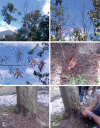Phytophthora cathayensis sp. nov., a new species pathogenic to Chinese Hickory (Carya cathayensis) in southeast China
- PMID: 34124619
- PMCID: PMC8165965
- DOI: 10.3114/fuse.2021.07.05
Phytophthora cathayensis sp. nov., a new species pathogenic to Chinese Hickory (Carya cathayensis) in southeast China
Abstract
Crown decline and mortality associated with collar lesions were observed on Carya cathayensis (Chinese hickory) trees in a plantation in Zhejiang province, China. Examination of active lesions resulted in the isolation of a homothallic, papillate Phytophthora sp. Detailed morphological and physiological studies and phylogenetic analysis, using ITS, beta-tubulin, cytochrome oxidase I, and heat shock protein 90 gene regions, revealed that all isolates belonged to an undescribed species residing in phylogenetic Clade 4, which is described here as Phytophthora cathayensis sp. nov. Inoculation trials were conducted under greenhouse conditions on C. cathayensis and C. illinoensis (pecan) plants to fulfill Koch postulates and hypothesize a possible pathway of the incursion. An existing report of a Phytophthora species with the same ITS sequence was reported on C. illinoensis from the USA in 2009. The difference in susceptibility of the two inoculated Carya species, and the report from the USA, suggest a possible introduction with plant material from the USA to China. Citation: Morales-Rodríguez C, Wang Y, Martignoni D, Vannini A (2020). Phytophthora cathayensis sp. nov., a new species pathogenic to Chinese Hickory (Carya cathayensis) in southeast China. Fungal Systematics and Evolution 7: 99-111. doi: 10.3114/fuse.2021.07.05.
Keywords: alien; global trade; invasive; new taxon; oomycetes; pecan; systematics.
© 2021 Westerdijk Fungal Biodiversity Institute.
Figures







References
-
- Ann PJ, Tsai JN, Yang HR. (2012). First report of leaf and stem downy blight of longan seedlings caused by Peronophythora litchii in Taiwan. Plant Disease 96: 1224. - PubMed
-
- Balci Y, Balci S, Blair JE, et al. . (2008). Phytophthora quercetorum sp. nov., a novel species isolated from eastern and north-central USA oak forest soils. Mycological Research 112: 906–916. - PubMed
-
- Blair JE, Coffey MD, Park S-Y, et al. . (2008). A multi-locus phylogeny for Phytophthora utilizing markers derived from complete genome sequences. Fungal Genetics and Biology 45: 266–277. - PubMed
-
- Bose T, Burgess TI, Roux J, et al. . (2017). Phytophthora alticola; emended description based on new collections and a neotype. Sydowia 69: 161–170.
-
- Brasier C. (2008). The biosecurity threat to the UK and global environment from international trade in plants Plant Pathology 57: 792–808.
LinkOut - more resources
Full Text Sources
